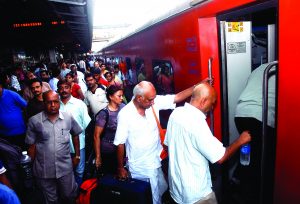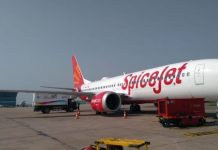 Indian Railways recorded all-time high Operating Ratio of 111.51 per cent during the first four months of the current financial year ending July 30, 2018. This means the railways spent rupees 111.51 to earn rupees one hundred during the period, making the behemoth public transporter financially most unviable. This reflects the shortfall in the estimated passenger and freight traffic targets with a higher outgo of working expenditure including pension payout.
Indian Railways recorded all-time high Operating Ratio of 111.51 per cent during the first four months of the current financial year ending July 30, 2018. This means the railways spent rupees 111.51 to earn rupees one hundred during the period, making the behemoth public transporter financially most unviable. This reflects the shortfall in the estimated passenger and freight traffic targets with a higher outgo of working expenditure including pension payout.
During the period, the railways earned 17,273.37 crores from passenger traffic against the target of 17,736.09 crores, indicating heavy losses in passenger earnings. Passenger services are cross-subsidised by earnings from freight traffic. Freight traffic performed below the target at 36, 480.41 crores against the target of 39, 253.41 crores. Total earnings of railways from passenger and freight traffic as also from sundry earnings in April-July is 56, 717.84 crores against the target of 61, 902.51 crores, whereas working expenditure exceeded the budgetary targeted sum of 50, 487.36 crores to 52, 517.71 crores.
Other expenditure on account of pension liability, Railway Board and railway institutions, in addition to ordinary expenditure involved, also exceeded the total income, resulting in the Operating Ratio touching an all-time high of 111.51. However, the first four months of the current fiscal year 2018-19 is a lean period and Operating Ratio improves during the last quarter of the fiscal year, as usual.
Operating Ratio has been above 92 years on year basis in the recent past. For 2018-19, Operating Ratio is estimated at 92.8 per cent against 96 per cent in 2017-18. Railways are pinning high hopes on freight earnings with targeted incremental freight traffic of 51 million tones in the current fiscal year 2018-19. Last quarter of the financial year helps railways pick up freight traffic, giving hopes that the freight target will be achieved.
Indian Railways have allocated 1.48 lakh crores capital expenditure for capacity augmentation, renewal of assets, electrification, redevelopment of stations and upgradation of its total infrastructure. Railway Board maintains that every time Pay Commission comes, Operating Ratio, indicator of financial health of Indian Railways, is on the higher side. Operating Ratio is the ratio of working expenditure, arising from day to day operations, to revenue earned from traffic. It increases beyond the target that recovers generally by the end of the financial year.
Earlier, a report on financial status of Indian Railways, presented with the General Budget 2018-19 on February 1, 2018 in Parliament, painted dismal picture of its financial health indicating that the railways have to remain financially viable on borrowed money from market and other sources. As a result of merger of Railways budget with the General Budget since 2017-18, Railways escaped dedicated media focus and for that matter public scrutiny of its overall functioning altogether, the casualty being the impugned report on its financial status from public notice. That is how Indian Railways have lost its sheen in public glare. It comes on the fore in public domain only when accidents take place with heavy casualties
In short, capital expenditure of Indian Railways is increasingly being financed through borrowings from 8 per cent in 2010-11 to 55 percent in 2018-19, a sorry state of railways financial viability. It is to be noted that private investments in the railways are not forthcoming, said a Railway Board source. It calls for massive investments by the Union Government to maintain balance between commercial status and social responsibility of Indian Railways as the one and only modes of mass transportation of core commodities and bulk of our people who cannot afford other modes of transportation.
letters@tehelka.com












